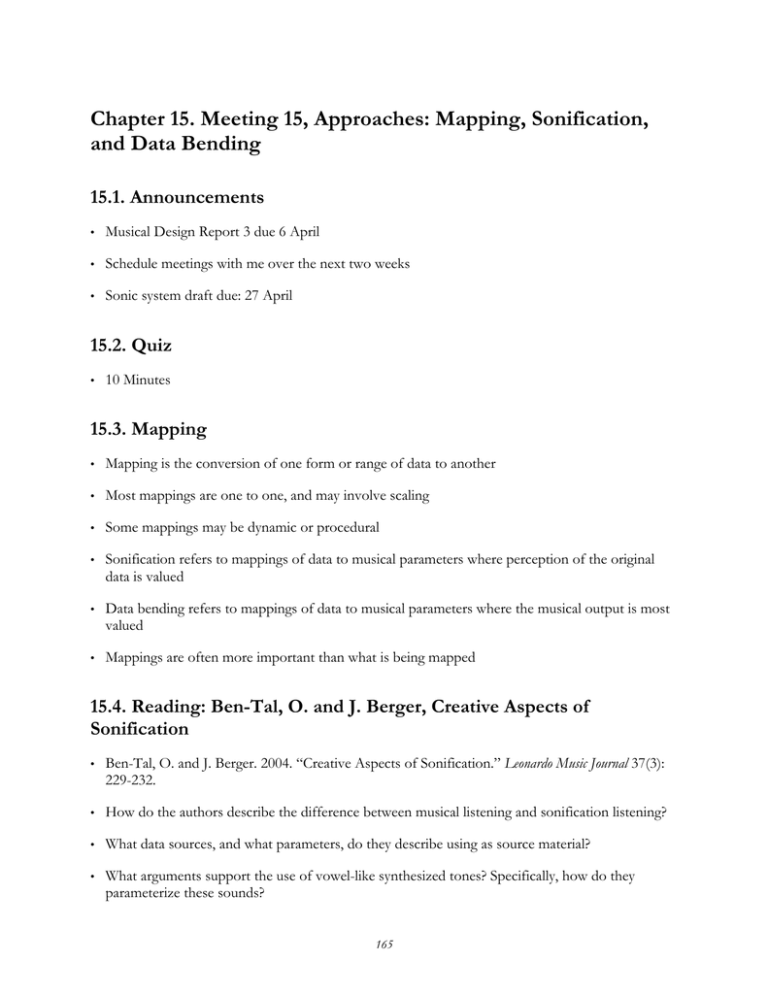
Chapter 15. Meeting 15, Approaches: Mapping, Sonification,
and Data Bending
15.1. Announcements
•
Musical Design Report 3 due 6 April
•
Schedule meetings with me over the next two weeks
•
Sonic system draft due: 27 April
15.2. Quiz
•
10 Minutes
15.3. Mapping
•
Mapping is the conversion of one form or range of data to another
•
Most mappings are one to one, and may involve scaling
•
Some mappings may be dynamic or procedural
•
Sonification refers to mappings of data to musical parameters where perception of the original
data is valued
•
Data bending refers to mappings of data to musical parameters where the musical output is most
valued
•
Mappings are often more important than what is being mapped
15.4. Reading: Ben-Tal, O. and J. Berger, Creative Aspects of
Sonification
•
Ben-Tal, O. and J. Berger. 2004. “Creative Aspects of Sonification.” Leonardo Music Journal 37(3):
229-232.
•
How do the authors describe the difference between musical listening and sonification listening?
•
What data sources, and what parameters, do they describe using as source material?
•
What arguments support the use of vowel-like synthesized tones? Specifically, how do they
parameterize these sounds?
165
•
What advantages do sonification, as type of auditory display, have over visual displays?
15.5. Data Bending
•
Mapping of arbitrary data to musical parameters
•
Data sonification
•
Macro: can be applied to note-level parameters
•
Micro: can be applied at the sample level
•
Always requires some sort of mapping
15.6. Macro Data Bending: Joseph Schillinger
•
Joseph Schillinger (1895-1943): Russian immigrant to the US
•
Schillinger, J. 1941. The Schillinger System of Musical Composition. New York: Carl Fischer.
•
Schillinger, J. 1948. The Mathematical Basis of the Arts. New York: Carl Fischer.
•
Explored relationships of musical composition to mathematics
•
Explored approaches to generating musical parameters
166
© source unknown. All rights reserved. This content is excluded from our Creative
Commons license. For more information, see http://ocw.mit.edu/fairuse.
15.7. Macro Data Bending: Natural Data
•
Audio: Charles Dodge: “Earth’s Magnetic Fields”, 1970
•
Musical setting of values produced by an index of the effect of the sun’s radiation on the magnetic
field that surrounds the Earth
•
Larry Austin: Canadian Coastlines
•
Tracings of outlines of Canadian bodies of water to choose musical parameters such as pitch,
rhythm, timbre, and duration
167
Courtesy of Larry Austin. Used with permission.
15.8. Macro Data Bending: Natural Data
•
DNA, amino acid sequences in protein, and other natural data sets have frequently been used as a
source material for procedural compositions
•
Often, claims of aesthetic value are attributed due only to the source data; mapping is incorrectly
treated as neutral
•
Mary Ann Clark
Numerous examples created with ArtWonk software from Algorithmic Arts
http://www.whozoo.org/mac/Music/samples.htm
•
Linda Long: Music of the Plants
168
http://www.molecularmusic.com
15.9. Micro Data Bending
•
Mapping non-musical data to audio-rate data
•
Can map to an arbitrary binary data representation
•
Can map to positions of individual amplitude points
15.10. Micro Data Bending: Arbitrary Data as Audio File
•
Read images other file types as audio data: UPIC, MetaSynth
•
Import arbitrary data as audio data
•
Audacity: Project: Import Raw Data...
Example: AN0008-amesRetrospect.pdf
15.11. UPIC
•
Unité Polyagogique Informatique du CEMAMu (UPIC),
•
Users draw waveforms, envelopes, and textures
•
Integrated hardware system
© source unknown. All rights reserved. This content is excluded from our Creative
Commons license. For more information, see http://ocw.mit.edu/fairuse.
169
© Iannis Xenakis. All rights reserved. This content is excluded from our Creative
Commons license. For more information, see http://ocw.mit.edu/fairuse.
•
Audio: “Mycenae-Alpha,” 1978
•
Mycenae-Alpha visualization synchronized to the score
Video: YouTube (http://www.youtube.com/watch?v=yztoaNakKok)
•
“Children may draw a fish or a house and listen to what they have made and correct it. They can
learn, progressively through designing, to think musical composition without being tormented by
solfège or by incomplete mastery of a musical instrument.... But as they are led to construct
rhythms, scales, and more complex things, they are also forced to combine arithmetic and
geometric forms: music. From whence comes an interdisciplinary pedagogy through playing."
(Xenakis 1985).
170
15.12. Reading: Marino, G. and M. Serra, J. Raczinski, The UPIC
System: Origins and Innovations
•
Marino, G. and M. Serra, J. Raczinski. 1993. “The UPIC System: Origins and Innovations.”
Perspectives of New Music 31(1): 258-269.
•
Evaluate this idea and claim: “Another idea was to let the composer control and create all aspects
of the composition: sound, symbols, syntax, and so forth. This means that the system should not
impose predefined sounds, predefined compositional process, predefined structures, and so on. It
is essential for the creative mind that ideas not go through theories or limitations that might not
suit the composer.”
•
What are some of the technical features of this version of UPIC?
•
Where (on what machine components) does the signal processing occur?
•
What opportunities exist for non-sinusoidal sounds?
15.13. Contemporary UPIC Variants
•
MetaSynth (Mac; commercial)
171
© U&I Software. All rights reserved. This content is excluded from our Creative
Commons license. For more information, see http://ocw.mit.edu/fairuse.
http://www.uisoftware.com/MetaSynth
•
HighC: (Windows, Mac, Unix; commercial)
http://highc.org
•
SPEAR (Windows, Mac; free)
Designed for audio analysis and resynthesis; permits drawing spectra
http://www.klingbeil.com/spear/
•
HyperScore: Anyone Can Compose Music
A note-event (not synthesis) approach to writing common practice (tonal, pitched) music
http://www.hyperscore.com
172
MIT OpenCourseWare
http://ocw.mit.edu
21M.380 Music and Technology: Algorithmic and Generative Music
Spring 2010
For information about citing these materials or our Terms of Use, visit: http://ocw.mit.edu/terms.




